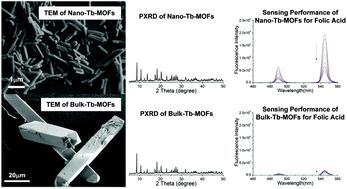Our official English website, www.x-mol.net, welcomes your
feedback! (Note: you will need to create a separate account there.)
Size-controlled synthesis of metal-organic frameworks and their performance as fluorescence sensors.
Analyst ( IF 3.6 ) Pub Date : 2020-08-19 , DOI: 10.1039/d0an01566k Kui Ren 1 , Xiao-Feng Guo , Ying-Jie Tang , Bo-Hui Huang , Hong Wang
Analyst ( IF 3.6 ) Pub Date : 2020-08-19 , DOI: 10.1039/d0an01566k Kui Ren 1 , Xiao-Feng Guo , Ying-Jie Tang , Bo-Hui Huang , Hong Wang
Affiliation

|
Metal–Organic Frameworks (MOFs) are of bright promise as new fluorescence sensors because of their accurate framework structure and unique fluorescence properties. Many MOFs have been reported as fluorescence sensors, including bulk-MOF-crystals and nano-MOF-powder. Obviously, the sensing performance of these MOF sensors should be diverse due to their different sizes. However, bulk-MOF-crystals and nano-MOF-powder have completely different dispersibility in solvents, and the effects of this difference on the analytical performance like precision and sensitivity are significant but have not been discussed systematically. To investigate such effects, rodlike bulk-MOFs and nano-MOFs with the same structure but different sizes are required. In this work, we obtained MOFs with a crystal width ranging from 9.7 μm to 170 nm by controlled synthesis, and then proved that they have the same structure by PXRD, SEM, TGA and FTIR analysis. After that, taking folic acid as the target molecule, fluorescent sensing experiments were carried out to compare the sensing performance between bulk-MOFs and nano-MOFs. From the results, we found that nano-MOFs have obviously better dispersity, a lower precipitation speed, a smaller standard deviation, ten times higher fluorescence intensities and a much lower LOD than bulk-MOFs. Finally, we draw a conclusion that nano-MOFs are more in line with the requirements of analytical performance as fluorescence sensors, and the size of MOFs as fluorescence sensors should be as small as possible.
中文翻译:

金属有机骨架的尺寸控制合成及其作为荧光传感器的性能。
金属有机框架(MOF)由于其精确的框架结构和独特的荧光特性,有望作为新型荧光传感器。据报道,许多MOF作为荧光传感器,包括块状MOF晶体和纳米MOF粉。显然,由于大小不同,这些MOF传感器的感测性能也应有所不同。然而,块状MOF晶体和纳米MOF粉末在溶剂中的分散性完全不同,这种差异对分析性能(如精密度和灵敏度)的影响是显着的,但尚未进行系统地讨论。为了研究这种效应,需要具有相同结构但大小不同的棒状体MOF和纳米MOF。在这项工作中,我们通过受控合成获得了晶体宽度为9.7μm至170 nm的MOF,然后通过PXRD,SEM,TGA和FTIR分析证明它们具有相同的结构。之后,以叶酸为靶分子,进行了荧光传感实验,比较了本体MOF和纳米MOF的传感性能。从结果中,我们发现纳米MOF的分散性明显好于本体MOF,沉淀速度更低,标准偏差更小,荧光强度高十倍,LOD更低。最后,我们得出的结论是,纳米MOF更符合作为荧光传感器的分析性能的要求,并且作为荧光传感器的MOF的尺寸应尽可能小。进行了荧光传感实验以比较体相MOF和纳米MOF的传感性能。从结果中,我们发现纳米MOF的分散性明显好于本体MOF,沉淀速度更低,标准偏差更小,荧光强度高十倍,LOD更低。最后,我们得出的结论是,纳米MOF更符合作为荧光传感器的分析性能的要求,并且作为荧光传感器的MOF的尺寸应尽可能小。进行了荧光传感实验以比较体相MOF和纳米MOF的传感性能。从结果中,我们发现,纳米MOF的分散性明显好于本体MOF,沉淀速度更低,标准偏差更小,荧光强度高十倍,LOD更低。最后,我们得出的结论是,纳米MOF更符合作为荧光传感器的分析性能的要求,并且作为荧光传感器的MOF的尺寸应尽可能小。
更新日期:2020-09-15
中文翻译:

金属有机骨架的尺寸控制合成及其作为荧光传感器的性能。
金属有机框架(MOF)由于其精确的框架结构和独特的荧光特性,有望作为新型荧光传感器。据报道,许多MOF作为荧光传感器,包括块状MOF晶体和纳米MOF粉。显然,由于大小不同,这些MOF传感器的感测性能也应有所不同。然而,块状MOF晶体和纳米MOF粉末在溶剂中的分散性完全不同,这种差异对分析性能(如精密度和灵敏度)的影响是显着的,但尚未进行系统地讨论。为了研究这种效应,需要具有相同结构但大小不同的棒状体MOF和纳米MOF。在这项工作中,我们通过受控合成获得了晶体宽度为9.7μm至170 nm的MOF,然后通过PXRD,SEM,TGA和FTIR分析证明它们具有相同的结构。之后,以叶酸为靶分子,进行了荧光传感实验,比较了本体MOF和纳米MOF的传感性能。从结果中,我们发现纳米MOF的分散性明显好于本体MOF,沉淀速度更低,标准偏差更小,荧光强度高十倍,LOD更低。最后,我们得出的结论是,纳米MOF更符合作为荧光传感器的分析性能的要求,并且作为荧光传感器的MOF的尺寸应尽可能小。进行了荧光传感实验以比较体相MOF和纳米MOF的传感性能。从结果中,我们发现纳米MOF的分散性明显好于本体MOF,沉淀速度更低,标准偏差更小,荧光强度高十倍,LOD更低。最后,我们得出的结论是,纳米MOF更符合作为荧光传感器的分析性能的要求,并且作为荧光传感器的MOF的尺寸应尽可能小。进行了荧光传感实验以比较体相MOF和纳米MOF的传感性能。从结果中,我们发现,纳米MOF的分散性明显好于本体MOF,沉淀速度更低,标准偏差更小,荧光强度高十倍,LOD更低。最后,我们得出的结论是,纳米MOF更符合作为荧光传感器的分析性能的要求,并且作为荧光传感器的MOF的尺寸应尽可能小。











































 京公网安备 11010802027423号
京公网安备 11010802027423号